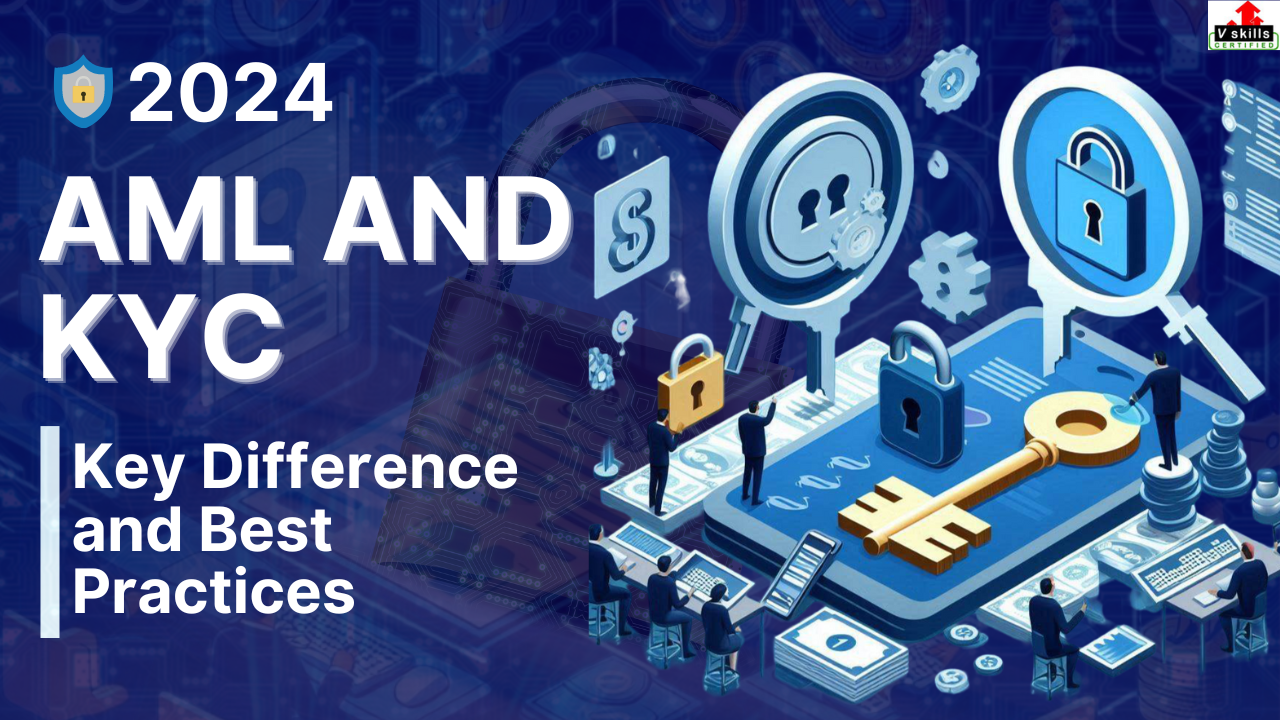In today’s complex financial landscape, ensuring the integrity of transactions and safeguarding against financial crimes is paramount. Two key pillars in this endeavor are Know Your Customer (KYC) and Anti-Money Laundering (AML). While often used interchangeably, these terms represent distinct yet interconnected processes. This blog delves into the nuances between KYC and AML, exploring their respective goals, methodologies, and best practices. By understanding the core differences and synergies between KYC and AML, businesses can establish robust compliance frameworks to mitigate risks and foster trust.
What is KYC?
Know Your Customer (KYC) is a fundamental due diligence process employed by financial institutions and regulated entities to verify the identity and assess the risk profile of their clients. By meticulously collecting and validating essential information, such as identification documents, proof of address, and financial history, businesses aim to establish a clear understanding of their customer base. This proactive approach is instrumental in preventing fraud, identity theft, and other financial malpractices.
Key components of KYC:
- Customer identification: Gathering accurate and verifiable information about the customer, encompassing details like name, date of birth, address, and government-issued identification.
- Customer verification: Validating the authenticity of the provided information through rigorous document verification and potentially supplementary checks.
- Ongoing monitoring: Continuously evaluating customer relationships and transaction patterns to identify any anomalies or suspicious activities.
What is AML?
Anti-Money Laundering (AML) is a comprehensive framework of policies, procedures, and regulations designed to prevent criminals from disguising the proceeds of illegal activities as legitimate funds. Financial institutions play a pivotal role in this battle by implementing robust AML measures to detect, report, and deter money laundering. By carefully monitoring financial transactions and identifying suspicious activities, these institutions contribute significantly to combating financial crime.
Key components of AML:
- Risk assessment: Evaluating the potential money laundering risks associated with customers, products, services, and geographic locations.
- Customer due diligence (CDD): Conducting thorough checks on customers to understand their business activities, financial profiles, and source of funds.
- Transaction monitoring: Analyzing transaction patterns to identify unusual or suspicious activities that may indicate money laundering.
- Suspicious activity reporting (SAR): Reporting suspicious transactions to the relevant authorities.
Key Differences Between KYC and AML
While often used interchangeably, Know Your Customer (KYC) and Anti-Money Laundering (AML) represent distinct yet interconnected components of a robust compliance framework.
KYC primarily focuses on establishing and verifying the identity of customers, serving as a foundational element in building trust and mitigating risks. Conversely, AML encompasses a broader spectrum of activities aimed at preventing the illicit movement of funds, including money laundering and terrorist financing.
KYC involves a meticulous process of customer identification, verification, and ongoing monitoring. It entails collecting accurate and verifiable information about customers, such as name, date of birth, address, and government-issued identification. Subsequently, this information is cross-referenced with reliable databases to authenticate the customer’s identity. The KYC process also includes continuous monitoring of customer relationships and transaction patterns to detect any discrepancies or suspicious activities.
On the other hand, AML mandates a more comprehensive approach that encompasses risk assessment, customer due diligence (CDD), transaction monitoring, and suspicious activity reporting (SAR). Financial institutions are required to evaluate the potential money laundering risks associated with their customers, products, services, and geographic locations.
This risk assessment informs the level of due diligence applied to customers. CDD involves conducting thorough checks on customers to understand their business activities, financial profiles, and sources of funds. Transaction monitoring entails analyzing transaction patterns to identify unusual or suspicious activities that may indicate money laundering. Finally, SAR mandates reporting suspicious transactions to the relevant authorities.
While KYC is an integral part of AML compliance, it is essential to recognize their distinct objectives and the specific activities involved in each process. By understanding these differences, financial institutions can develop more effective and targeted compliance programs to mitigate risks and protect their reputation.
Comparison Table: AML VS KYC
| Feature | KYC | AML |
| Primary Focus | Customer identification and verification | Preventing money laundering and terrorist financing |
| Scope | Limited to customer information and identity | Encompasses risk assessment, CDD, transaction monitoring, and SAR |
| Objective | Establish customer identity, mitigate fraud risk | Detect and prevent money laundering, comply with regulations |
| Key Activities | Customer onboarding, identity verification, ongoing monitoring | Risk assessment, customer due diligence, transaction monitoring, SAR |
| Regulatory Drivers | Customer protection, fraud prevention | Financial crime prevention, regulatory compliance |
By clearly delineating the responsibilities and activities associated with KYC and AML, financial institutions can allocate resources effectively, enhance compliance efforts, and strengthen their overall risk management framework.
Best Practices for KYC and AML
Implementing robust KYC and AML procedures is imperative for financial institutions to safeguard their reputation, mitigate risks, and comply with regulatory mandates. By adhering to industry best practices and leveraging technology, organizations can effectively combat financial crime and build trust with customers.
1. Risk Assessment
A cornerstone of effective KYC and AML programs, risk assessment involves identifying potential vulnerabilities within an organization. By evaluating factors such as customer type, geographic location, product or service offerings, and transaction patterns, financial institutions can prioritize efforts and allocate resources accordingly. A comprehensive risk assessment forms the foundation for determining the appropriate level of due diligence for each customer.
2. Customer Due Diligence (CDD)
Thorough customer due diligence is essential for understanding a customer’s business activities, financial profile, and source of funds. This process encompasses verifying customer identity, obtaining beneficial ownership information, and assessing the purpose and nature of the business relationship. For high-risk customers, enhanced due diligence (EDD) may be necessary, involving additional checks and ongoing monitoring.
3. Transaction Monitoring
Effective transaction monitoring is crucial for identifying unusual or suspicious activities that may signal money laundering or terrorist financing. Financial institutions should implement robust systems to analyze transaction patterns, detect anomalies, and flag potential red flags. Advanced analytics and artificial intelligence can significantly enhance the efficiency and effectiveness of transaction monitoring.
4. Suspicious Activity Reporting (SAR)
Prompt and accurate reporting of suspicious activities is vital for disrupting financial crime. Financial institutions must have clear procedures in place for identifying, documenting, and reporting suspicious transactions to the relevant authorities. SARs should be based on solid evidence and include detailed information about the suspicious activities and the involved parties.
5. Employee Training
A well-trained workforce is essential for successful KYC and AML compliance. Financial institutions should invest in comprehensive training programs that cover KYC and AML regulations, procedures, and red flags. Employees at all levels should understand their roles and responsibilities in preventing financial crime.
6. Technology and Innovation
Leveraging technology can significantly enhance KYC and AML processes. Emerging technologies such as artificial intelligence, machine learning, and blockchain offer opportunities to streamline customer onboarding, improve identity verification, and enhance transaction monitoring. Financial institutions should explore these innovations to stay ahead of evolving threats and regulatory requirements.
KYC and AML in Different Industries
The significance of KYC and AML extends beyond the traditional financial sector, permeating various industries. As the global economy evolves, the risk of financial crime has expanded, necessitating the implementation of robust KYC and AML measures across diverse sectors.
1. Banking and Financial Institutions
The banking and financial services industry is at the epicenter of KYC and AML regulations. These institutions handle vast sums of money and are prime targets for money laundering and terrorist financing. Comprehensive KYC procedures, including customer identification, verification, and ongoing monitoring, are essential for mitigating risks. Additionally, robust transaction monitoring systems are employed to detect suspicious activities and report them to regulatory authorities.
2. Fintech
The rapid growth of fintech has introduced new challenges and opportunities in the realm of KYC and AML. Fintech companies, such as digital payment platforms and cryptocurrency exchanges, must navigate a complex regulatory landscape while ensuring customer protection. Implementing innovative KYC solutions, leveraging technology, and staying abreast of emerging threats are crucial for fintech firms to maintain compliance.
3. Real Estate
The real estate sector is increasingly subject to KYC and AML scrutiny due to its potential for money laundering. Real estate transactions often involve substantial sums of cash, making them attractive to criminals. Real estate agents, brokers, and developers must implement KYC measures to verify the identity of clients and assess the source of funds. Additionally, monitoring for suspicious transactions and adhering to reporting obligations are essential.
4. Gaming and Gambling
The gaming and gambling industry is susceptible to money laundering due to the high volume of cash transactions involved. Casinos, online gambling platforms, and lottery operators must implement stringent KYC and AML controls to prevent illicit activities. This includes verifying customer identities, monitoring for unusual betting patterns, and reporting suspicious transactions to regulatory authorities.
5. Art and Antiques
The art and antiques market is known for its high-value transactions and potential for money laundering. Art dealers, auction houses, and galleries must implement KYC procedures to verify the identity of clients and assess the source of funds for high-value purchases. Additionally, monitoring for suspicious transactions and adhering to reporting obligations are essential to prevent the use of art as a vehicle for money laundering.
6. Other Industries
KYC and AML obligations extend beyond the aforementioned sectors. Industries such as legal services, virtual asset service providers, and trade finance are increasingly subject to KYC and AML regulations. The specific requirements vary depending on the nature of the business and the jurisdictions in which it operates.
As the global regulatory landscape evolves, businesses across various industries must stay informed about KYC and AML requirements. By implementing robust compliance programs, organizations can protect their reputation, mitigate risks, and contribute to a safer financial ecosystem.
Challenges and Opportunities in KYC and AML
Implementing and maintaining effective KYC and AML programs present a complex interplay of challenges and opportunities. Financial institutions must navigate a dynamic regulatory landscape while balancing customer experience and operational efficiency.
Challenges in KYC and AML
- Regulatory Complexity: The ever-evolving regulatory environment poses significant challenges for financial institutions. Keeping abreast of changes, interpreting regulations accurately, and ensuring compliance across different jurisdictions can be overwhelming.
- Customer Onboarding: Balancing the need for thorough due diligence with the desire to provide a seamless customer experience is a delicate task. Striking the right balance between security and efficiency is crucial.
- Emerging Threats: Financial crime evolves rapidly, with new tactics and technologies emerging constantly. Staying ahead of these threats requires continuous monitoring and adaptation of KYC and AML programs.
- Data Management: Managing large volumes of customer data and maintaining data quality is essential for effective KYC and AML compliance. Data privacy regulations add another layer of complexity.
- Cost and Resources: Implementing and maintaining robust KYC and AML programs can be costly and resource-intensive. Balancing compliance requirements with operational efficiency is a key challenge.
Opportunities in KYC and AML
- Technology Innovation: Emerging technologies such as artificial intelligence, machine learning, and blockchain offer significant opportunities to enhance KYC and AML processes. These technologies can automate tasks, improve accuracy, and reduce operational costs.
- Customer Experience: By leveraging technology and streamlining processes, financial institutions can improve the customer onboarding experience while maintaining compliance.
- Risk Mitigation: Effective KYC and AML programs can help mitigate reputational and financial risks associated with financial crime.
- Competitive Advantage: Demonstrating a strong commitment to KYC and AML compliance can enhance a financial institution’s reputation and attract customers who value security and trust.
- Regulatory Advantage: Proactive adoption of best practices can position financial institutions as industry leaders, potentially influencing regulatory developments.
Conclusion
In conclusion, KYC and AML are indispensable components of a robust compliance framework for organizations operating in today’s complex financial landscape. While they present distinct challenges, the rewards of effective implementation are substantial. By understanding the intricacies of KYC and AML, embracing technological advancements, and fostering a culture of compliance, financial institutions can mitigate risks, protect their reputation, and contribute to a safer financial ecosystem. As the regulatory environment continues to evolve, staying informed about emerging trends and best practices will be crucial for organizations to navigate the complexities of KYC and AML compliance successfully.
FAQs: KYC and AML
Below are some of the common and frequently asked questions related to KYC and AML:
1. What is the AML/KYC full form?
KYC and AML full form:
- AML stands for Anti-Money Laundering. It’s a set of procedures, laws, and regulations designed to prevent criminals from disguising illegally obtained money as legitimate funds.
- KYC stands for Know Your Customer. It’s a process to verify the identity and assess the risk profile of clients to prevent fraud, money laundering, and other financial crimes.
2. What is AML in KYC?
AML (Anti-Money Laundering) is a broader framework that encompasses KYC as a crucial component. While KYC focuses on identifying and verifying customers, AML takes it a step further to prevent the use of the financial system for illicit activities. Think of AML as an umbrella term covering various measures to combat financial crime. KYC is one of the key pillars under this umbrella. Here’s how AML relates to KYC:
- KYC provides the foundational information needed for AML processes.
- The data gathered through KYC helps assess a customer’s risk profile for money laundering activities.
- KYC information is used to establish normal transaction patterns, which helps identify suspicious activities.
- KYC is a core part of Customer Due Diligence (CDD), a broader AML requirement to understand the customer and their financial dealings.
3. What is the primary objective of a KYC, AML, and CFT policy in banks?
The primary objective of a KYC, AML, and CFT policy in banks is to prevent the misuse of the banking system for money laundering and terrorist financing activities. These policies ensure that banks conduct thorough customer due diligence (KYC), implement robust measures to detect and report suspicious transactions (AML), and take steps to prevent the financing of terrorism (CFT). Ultimately, these policies help maintain the integrity of the financial system and protect the bank’s reputation.
4. What are AML and KYC in banking?
AML (Anti-Money Laundering) is a set of rules and procedures banks follow to prevent money earned illegally from being disguised as legitimate income. KYC (Know Your Customer) is a part of AML. It means banks verify a customer’s identity and understand their financial activities to prevent fraud, money laundering, and other financial crimes.
5. What is the purpose of a KYC and AML policy in a financial institution?
Answer: A KYC (Know Your Customer) and AML (Anti-Money Laundering) policy is designed to protect the financial institution by identifying and verifying customers, assessing their risk levels, and detecting suspicious activities. It helps prevent money laundering, terrorist financing, and fraud.
6. What is the primary objective of conducting KYC and AML procedures?
Answer: The primary objective of KYC and AML procedures is to prevent financial institutions from being used for money laundering and terrorist financing activities. By understanding customers and their financial transactions, banks can identify suspicious activities and protect their reputations.
7. What is the purpose of KYC and AML guidelines?
KYC and AML guidelines provide a framework for financial institutions to implement measures that prevent money laundering and terrorist financing. These guidelines outline the procedures for identifying and verifying customers, assessing risks, monitoring transactions, and reporting suspicious activities. Compliance with these guidelines helps protect the financial system and maintain the integrity of the institution.
8. What is AML in banking?
AML in banking is a set of rules and procedures designed to prevent criminals from disguising illegally obtained money as legitimate income. Banks use AML to detect and report suspicious activities, safeguarding the financial system.
9. What is the AML domain?
The AML domain encompasses the entire spectrum of activities and processes related to preventing money laundering and terrorist financing. It involves understanding and complying with regulations, conducting customer due diligence (KYC), monitoring transactions, and reporting suspicious activities. Essentially, it’s the field focused on safeguarding the financial system from illicit activities.
10. What are the core elements of AML-KYC?
The core elements of AML/KYC include:
- Customer identification and verification (KYC): Knowing who your customers are.
- Risk assessment: Evaluating customers based on potential risks.
- Customer due diligence (CDD): Understanding customer activities and financial profiles.
- Transaction monitoring: Analyzing financial transactions for suspicious activity.
- Suspicious activity reporting (SAR): Reporting suspicious transactions to authorities.
11. What are the main components of KYC?
The core components of KYC (Know Your Customer) include:
- Customer identification: Collecting and verifying customer information.
- Customer due diligence: Assessing the customer’s risk profile.
- Ongoing monitoring: Continuously reviewing customer activities and transactions.
12. What is AML verification?
AML verification involves the process of checking and confirming customer information to prevent money laundering. It includes verifying customer identity, assessing risk levels, and monitoring transactions for suspicious activities. This process is essential for ensuring that financial institutions comply with AML regulations.
13. What does it mean for a customer account to be KYC compliant?
A KYC compliant account means that the financial institution has verified the customer’s identity and gathered sufficient information to assess their risk profile. It indicates that the account holder has fulfilled all the necessary KYC requirements as mandated by regulations.
14. Why is KYC form paramount for financial institutions?
A KYC form is paramount for financial institutions as it is the primary document used to gather essential customer information. This information is crucial for verifying identity, assessing risk, and complying with anti-money laundering (AML) regulations. A complete and accurate KYC form is fundamental to building a secure customer relationship and protecting the institution from financial crimes.
15. What is CFT under KYC/AML regulations?
CFT stands for Combating the Financing of Terrorism. Under KYC/AML regulations, CFT refers to the measures taken to prevent the financial system from being used to fund terrorist activities. It’s closely linked to AML as both aim to protect the financial system from misuse.




